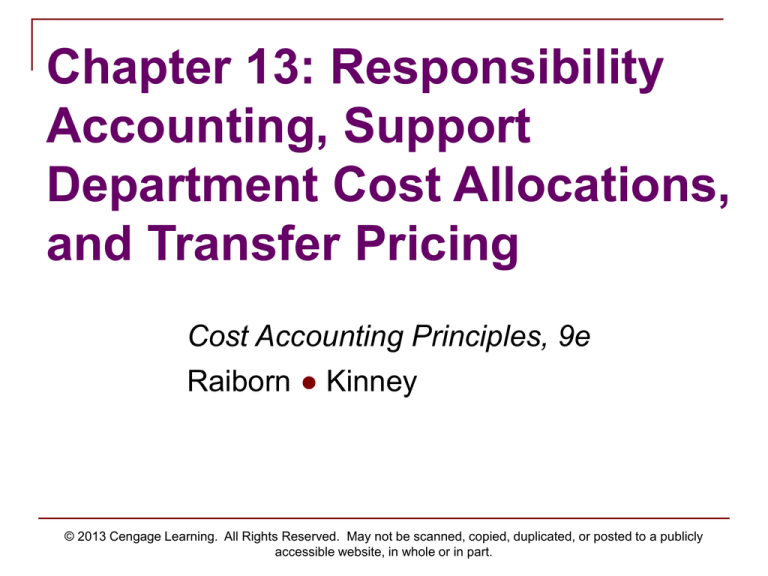
Chapter 13: Responsibility
Accounting, Support
Department Cost Allocations,
and Transfer Pricing
Cost Accounting Principles, 9e
Raiborn ● Kinney
© 2013 Cengage Learning. All Rights Reserved. May not be scanned, copied, duplicated, or posted to a publicly
accessible website, in whole or in part.
Learning Objectives
Which factors determine whether a firm should be
decentralized or centralized?
How are decentralization and responsibility accounting
related?
What are the four primary types of responsibility
centers, and what distinguishes them from each other?
How are revenue variances computed?
Why and how are support department costs allocated to
operating departments?
What types of transfer prices are used in organizations,
and why are such prices used?
What difficulties can be encountered by multinational
companies using transfer prices?
© 2013 Cengage Learning. All Rights Reserved. May not be scanned, copied, duplicated, or posted to a publicly
accessible website, in whole or in part.
Degree of centralization
Centralization – a single individual (usually the
company owner or president) makes all major
decisions and retains full authority and
responsibility for the organization’s activities
Decentralization – a transfer of authority,
responsibility, and decision-making rights from
the top to the bottom of the organizational
structure
© 2013 Cengage Learning. All Rights Reserved. May not be scanned, copied, duplicated, or posted to a publicly
accessible website, in whole or in part.
Decentralization Continuum
Factor
Age of firm
Size of firm
Stage of product
development
Growth rate
Impact on profits
of incorrect decisions
Management’s
confidence in
subordinates
Degree of control
Centralized
Decentralized
Young
Small
Mature
Large
Stable
Slow
Growth
Rapid
High
Low
Low
Tight
High
Moderate/loose
© 2013 Cengage Learning. All Rights Reserved. May not be scanned, copied, duplicated, or posted to a publicly
accessible website, in whole or in part.
Decentralization Continuum
Factor
Geographic
diversity
Cost of communications
Ability to resolve
conflicts
Level of employee
motivation
Level of organizational
flexibility
Response time to
changes
Centralized
Decentralized
Local
Low
Widespread
High
Easy
Difficult
Low
Moderate to high
Low
High
Slow
Rapid
© 2013 Cengage Learning. All Rights Reserved. May not be scanned, copied, duplicated, or posted to a publicly
accessible website, in whole or in part.
Advantages of Decentralization
Personnel
train and screen aspiring managers
develop leadership qualities, problem-solving
abilities, and decision-making skills
compare managers’ results
increase job satisfaction and job enrichment
Effective means of achieving organizational
goals
Reduces decision-making time
Allows management by exception
© 2013 Cengage Learning. All Rights Reserved. May not be scanned, copied, duplicated, or posted to a publicly
accessible website, in whole or in part.
Disadvantages of Decentralization
Lack of goal congruence
Suboptimization
pursuing the subunit manager’s goals instead of the
company’s goals
Requires more effective communication skills
Managers must relinquish control
Expensive
train managers in decision-making skills
absorb cost of poor decisions
requires a sophisticated planning and reporting system
© 2013 Cengage Learning. All Rights Reserved. May not be scanned, copied, duplicated, or posted to a publicly
accessible website, in whole or in part.
Responsibility Reports
Monetary and nonmonetary
Adjusted for the planning, controlling,
and decision-making needs of each unit
manager
Separates costs as controllable or
noncontrollable by the unit manager
© 2013 Cengage Learning. All Rights Reserved. May not be scanned, copied, duplicated, or posted to a publicly
accessible website, in whole or in part.
Nonmonetary Measures
Capacity measures
Target ROI
Desired/actual market
share
Throughput
Defects
Backorders
Complaints
On-time delivery
Manufacturing cycle
efficiency
Reduction of non-valueadded time
Employee suggestions
received/implemented
Unplanned production
interruptions
Schedule changes
Engineering changes
Safety violations
Absenteeism
© 2013 Cengage Learning. All Rights Reserved. May not be scanned, copied, duplicated, or posted to a publicly
accessible website, in whole or in part.
Control Process Steps
Plan
Gather actual data
Compare
Exert managerial influence
Compare
Plan
© 2013 Cengage Learning. All Rights Reserved. May not be scanned, copied, duplicated, or posted to a publicly
accessible website, in whole or in part.
Responsibility Accounting
Upward flow of information
From operations to top management
Unit level reports are detailed
Upper-level reports are summarized
Encourages management by exception
Major deviations are highlighted
© 2013 Cengage Learning. All Rights Reserved. May not be scanned, copied, duplicated, or posted to a publicly
accessible website, in whole or in part.
Responsibility Accounting
Disadvantages of responsibility
accounting:
Important details may not be visible at
upper management levels
Managers might “promote” their unit while
“blaming” their competitor units
Could lead to lack of goal congruence
Departmental interdependencies might not
be visible
© 2013 Cengage Learning. All Rights Reserved. May not be scanned, copied, duplicated, or posted to a publicly
accessible website, in whole or in part.
Responsibility Centers
Responsibility accounting systems
identify, measure, and report on
activities in responsibility centers
Cost center
Revenue center
Profit center
Investment center
© 2013 Cengage Learning. All Rights Reserved. May not be scanned, copied, duplicated, or posted to a publicly
accessible website, in whole or in part.
Service Cost Allocation Methods
Direct method
Step method
Benefits-provided ranking
Algebraic method
Simultaneous equations
© 2013 Cengage Learning. All Rights Reserved. May not be scanned, copied, duplicated, or posted to a publicly
accessible website, in whole or in part.
Transfer Pricing
Internal charges for the exchange of goods
or services within the organization
Promote goal congruence
Ensure optimal resource allocation
Promote operational efficiency
Make performance evaluation among segments more
comparable
Transform a cost center into a pseudo-profit center
For internal use only
Eliminated on external financial reports
Encourage managers to be entrepreneurial
© 2013 Cengage Learning. All Rights Reserved. May not be scanned, copied, duplicated, or posted to a publicly
accessible website, in whole or in part.
Transfer Pricing Systems
May cause disagreement among managers
Adds costs and takes time
May not work for all departments
May cause underutilization or overutilization
of services
May cause dysfunctional organizational
behavior
Causes a need for year-end entries to
eliminate transfer prices
© 2013 Cengage Learning. All Rights Reserved. May not be scanned, copied, duplicated, or posted to a publicly
accessible website, in whole or in part.
Multinational Transfer Pricing
Internal Objectives
Better goal
congruence
Better performance
evaluations
More motivated
managers
Better cash
management
External Objectives
Fewer taxes and tariffs
Fewer foreign
exchange risks
Better competitive
positions
Better relations with
government
© 2013 Cengage Learning. All Rights Reserved. May not be scanned, copied, duplicated, or posted to a publicly
accessible website, in whole or in part.
Multinational Transfer Pricing
Develop guidelines that are followed on a
consistent basis
Set transfer prices that reflect an arm’slength transaction
Be prepared for transfer pricing audits
Consider Advance Pricing Agreements—
binding contracts between a company and
taxing authorities that set an acceptable
transfer pricing methodology
© 2013 Cengage Learning. All Rights Reserved. May not be scanned, copied, duplicated, or posted to a publicly
accessible website, in whole or in part.
Questions
What are some advantages and
disadvantages of decentralization?
What are the four types of responsibility
centers?
Why are transfer prices used?
© 2013 Cengage Learning. All Rights Reserved. May not be scanned, copied, duplicated, or posted to a publicly
accessible website, in whole or in part.
Potential Ethical Issues
Managers who make decisions to benefit themselves
but not always the firm
Burying important details in responsibility reports
Allocating costs using “ability-to-bear” criterion
Shifting support department costs to inappropriate
departments
Not allowing managers to buy or sell externally in a
transfer pricing situation
Using transfer pricing to shift costs to low- or no-tax
locations
© 2013 Cengage Learning. All Rights Reserved. May not be scanned, copied, duplicated, or posted to a publicly
accessible website, in whole or in part.







